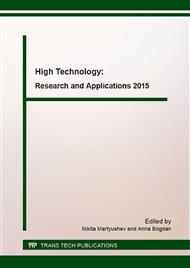[1]
V. An, Y. Irtegov, and C. de Izarra, Study of tribological properties of nanolamellar WS2 and MoS2 as additives to lubricants, Journal of Nanomaterials 2014 (2014) Article ID 865839.
DOI: 10.1155/2014/865839
Google Scholar
[2]
V. An, Y. Irtegov, Tribological properties of nanolamellar MoS2 doped with copper nanoparticles, Journal of Nanomaterials 2014 (2014) Article ID 731073.
DOI: 10.1155/2014/731073
Google Scholar
[3]
K.H. Hu, X.G. Hu, J. Wang, Y.F. Xu, C.L. Han, Tribological properties of MoS 2 with different morphologies in high-density polyethylene, Tribology Letters 47 (2012) 79-90.
DOI: 10.1007/s11249-012-9964-1
Google Scholar
[4]
S. Wang, G. Li, G. Du, X. Jiang, C. Feng, Z. Guo, S. Kim, Hydrothermal synthesis of molybdenum disulfide for lithium ion battery applications, Chinese Journal of Chemical Engineering 18 (2010) 910-913.
DOI: 10.1016/s1004-9541(09)60147-6
Google Scholar
[5]
M. Sun, J. Adjaye, A. E. Nelson, Theoretical investigations of the structures and properties of molybdenum-based sulfide catalysts, Applied Catalysis A 263 (2004) 131-143.
DOI: 10.1016/j.apcata.2003.12.011
Google Scholar
[6]
Y. Irtegov, V. An, P. Vinatier, N. Sochugov, A. Zakharov, Properties of WS2 films prepared by magnetron sputtering from a nanostructured target, Advanced Materials Research 872 (2014) 197-200.
DOI: 10.4028/www.scientific.net/amr.872.197
Google Scholar
[7]
T. Ryu, H.Y. Sohn, K. Hwang, Z. Fang, Chemical vapor synthesis (CVS) of tungsten nanopowder in a thermal plasma reactor, Int. Journal of Refractory Metals & Hard Materials 27 (2009) 149-154.
DOI: 10.1016/j.ijrmhm.2008.06.002
Google Scholar
[8]
Y. Moriysohi, M. Futaki, S. Komatsu, T. Ishigaki, The preparation and characterization of ultrafine tungsten powder, Journal of Materials Science Letters 16 (1997) 347-349.
DOI: 10.1023/a:1018586009506
Google Scholar
[9]
Y. -S. Kwon, Y. -H. Jung, N.A. Yavorovsky, A.P. Illyn, J. -S. Kim, Ultra-fine powder by wire explosion method, Scripta Materialia 44 (2001) 2247-2251.
DOI: 10.1016/s1359-6462(01)00757-6
Google Scholar
[10]
Y. Irtegov, V. An, M. Azhgikhin, Study of nanostructured metal sulfides produced by self-propagating high-temperature synthesis, Proceedings - 7th International Forum on Strategic Technology, IFOST 2012 (2012) article number 6357544.
DOI: 10.1109/ifost.2012.6357544
Google Scholar
[11]
E.N. Gryaznova, L.N. Shiyan, N.A. Yavorovskii, V.V. Korobochkin, Influence of the modification process on the properties of AlOOH nanofibers, Russian Journal of Applied Chemistry 86 Issue 3 (2013) 360-365.
DOI: 10.1134/s1070427213030129
Google Scholar
[12]
Yu.A. Kotov, Electric explosion of wires as a method for preparation of nanopowders, Journal of Nanoparticle Research 5 (2003) 539-550.
DOI: 10.1023/b:nano.0000006069.45073.0b
Google Scholar
[13]
V. Ivanov, S. Leonov, O. Gavrilyuk, V. Gerasimova, Self-propagating high-temperature synthesis of ultradisperse molybdenum disulfide, Combustion, Explosion, and Shock Waves 30 (1994) 54-58.
DOI: 10.1007/bf00755826
Google Scholar
[14]
Y. Irtegov, V. An, Study of tungsten and molybdenum nanopowders interaction with sulphur in SHS conditions and synthesized product properties, Advanced Materials Research 1040 (2014) 171-175.
DOI: 10.4028/www.scientific.net/amr.1040.171
Google Scholar


